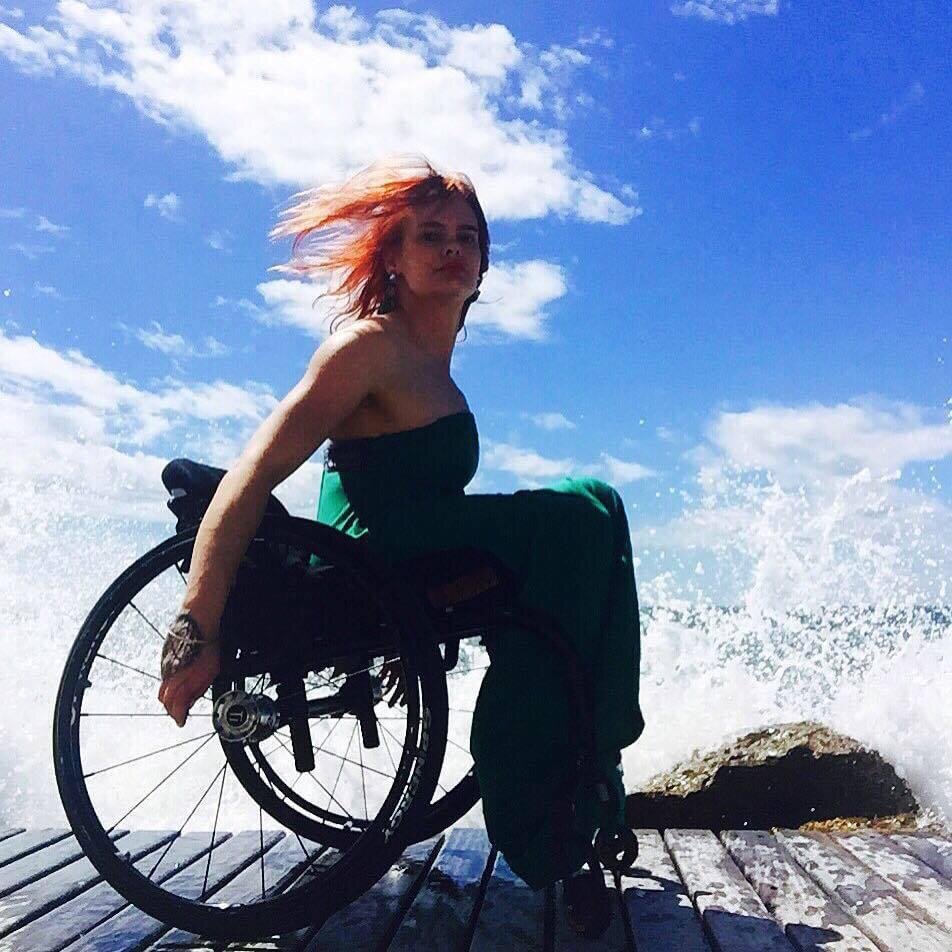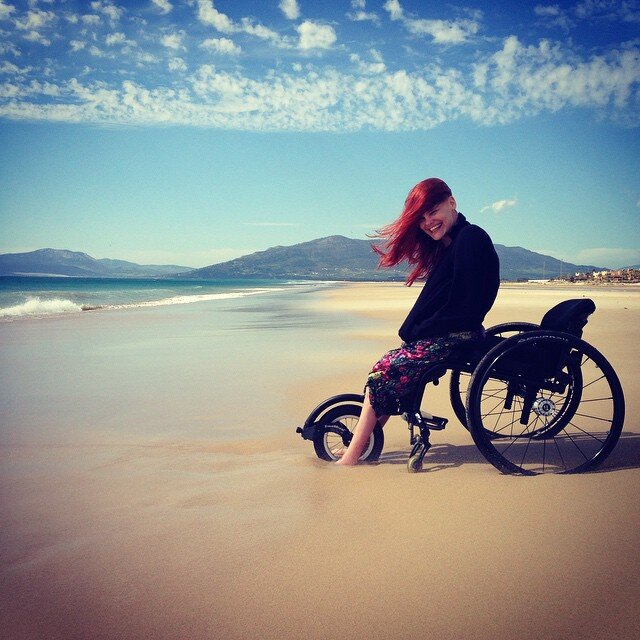The Queen of Cups
by FEATURED WRITER: Erin Clark
Erin Clark, She wears a spring dress by the sea shore, 2018. COURTESY of the artist.
The Queen of Cups
Erin Clark / Nov 2020 / Issue 3
The Queen of Cups sits on a throne at the edge of the water. Waves lick her toes and she holds a chalice and symbolizes things. What I always think when I see this tarot card is: someone had to bring in that throne.
I have had my wheelchair brought to the edge of the sea. Several seas (and a few rivers). It is very awkward and deliberate to get a throne queen-of-cups close to the water. A few times, I have arduously dragged my chair-self to the unprescribed edge and had to wave off or ignore the people on the promenade frantically worrying themselves into attempts to rescue me—from myself.
In the sand, the waves grab my wheels and pull, trying to bring me with them, sinking me deeper in place instead. I feel a very specific vertigo between the motion and not motion, the same as when the train next to you begins moving and your body goes with it but your train remains still. Soul carried out to sea, brought in again, my body still for the whole journey.
Like when I am in Spain and not fluent in Spanish, I feel that same vertigo. The sounds of the people around me grab my senses and try to pull me out, but I am sunk deeper into myself instead. I can only build friendships with people who mean it as much as I do, or who know how to bond by sight, so I am free from scripts and shallowness or false depth. I don’t know where things are or how they work or what my options are, so I am free from the rules. I can’t answer questions
Why is your body different
Why is it here
Why are your wheels
in the water
symbolizing things
I cannot answer, so I am free.
I flow between the sensory details of my environment and the sensory details of my insides. Throbbing, rhythmic, excited. Blood rushing in my ears, the sound of the sea in a shell. I feel myself inside myself.
It is like being in two places at once: the place everyone else is in, and the place I (alone) am in.
The tug between locations is me.
The tug is a kind of love.
When I am immersed in a setting but cannot immediately interpret it, I feel the tug/love keenly. I'm overcome with an urge to know that place the way I know myself. And the way I learn and love a new place is a new way I love myself. Which is what I did when I lived in Spain.
“Why did you move here?”
“To love.”
“¿Pero, de qué trabajas?”
“Soy escritora.”
They function the same way.
To write myself, I have to understand myself while being.
And I have to understand myself before that—even when you are unruled, you are still compelled—I have to understand myself completely, so much better than anyone else understands themselves. Maybe I have to understand them better, too.
My body is always foreign; no one knows where things are or how they work or what their options are, so they are free from the rules.
Rules are a pattern. Ripple formations on the sea bed below align with the water as it crests and spends its force above, formations sinking into flatness as the water tugs.
See? I know you.
Sea, I know you.
I want to be in Spain again. I want to be at the sea. Even though, when I was at the sea in that life, I was usually on a prescribed path—a pavement + beach + tide-length, boardwalk distance from the water—as-designated by the people who made the promenade and who brought in the sand.
I have been inside the pandemic-designated area of my room, inside my mom’s apartment, 6,511 km from my sea, for more than 150 days. My insides and my outsides are the same, like when the wallpaper and the upholstery are the same pattern, and faded. I am my mother. I am not inside myself, I am only, absolutely, here. That is not enough places to be, there is no tug.
At the sea, sand was brought in to make a beach for other people. The natural seashore is cliffs and rocks. Stone so porous it looks like a honeycomb and glows red and coral in the sunsets. I know this because I crawled over some of the rocks to get closer to the edge. I clung to the vertical face of those cliffs for sport and cried from adrenaline and confusion of being afraid and aroused and knowing finally that they are the same.
Some urban designers understood that some people would not be able to stroll romantically to the water. As if they knew me, or someone like me, my body was not foreign to them. Fluently, they built closer to the edges.
I wanted closer than that. I wanted intimacy more than I wanted ease. And because of the sand, and the promenades, and the cliffs, I got to choose.
From the interior of Canada, where the sea is in my mind, there is the sea and there is ease. I want to push closer. What I really want is to choose.
I want to leave this apartment and go until I am in Spain at the sea, and never arrive.
Erin Clark is the author of If You Really Love Me, Throw Me Off the Mountain and co-author of the upcoming Breakup Artist. Erin's work across film, self portraiture, creative nonfiction and fiction writing is a reclaiming of disability in narrative, which is historically and commonly extracted and misused in all areas of art and media. Her work explores what it means to portray and present herself, without mediation, in her own context, from her perspective. She is a Canadian world-traveller, world champion and record holder as a parapole athlete, and, as a paragliding pilot, Erin has a wheelchair that can fly.



